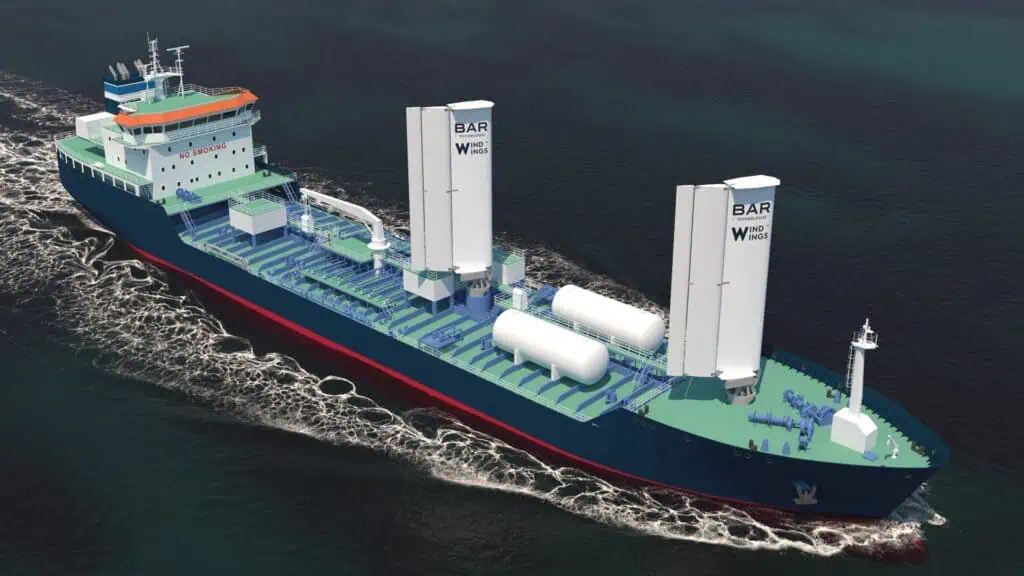BAR Technologies is expanding its WindWings ® portfolio with the launch of new 20m and 24m models, designed to save 0.7 tonnes of fuel per day per WindWin g® on average, on worldwide routes. Building on the global success of the 37.5m WindWings ®, which set new environmental and efficiency standards in shipping, these new models will make wind-assisted propulsion (WAP) technology accessible to a broader range of vessels, including handysize bulkers, chemical tankers, and other smaller ships, effectively increasing the target fleet size by nearly 50%. Weighing less than 30 tonnes, the new range are extremely economic and simple to fit on both newbuilds and retrofits.
WindWings®’ fuel-saving capabilities were first independently validated by DNV-Maritime in May 2024. Their deployment on vessels such as the Pyxis Ocean and Berge Olympus has already demonstrated a 32% reduction in energy use per nautical mile, solidifying WindWings® as a reliable and independently validated choice for shipowners. With the International Maritime Organization’s (IMO’s) 2030 target of reducing GHG emissions from international shipping by 20-30% only 5.5 years away, WindWings® are now essential for helping shipowners achieve these goals.
John Cooper, CEO of BAR Technologies, said: “The incredible success of our 37.5m WindWings® model has proven that wind-assisted propulsion is now a validated and trusted solution for increasing fuel savings and reducing emissions in international shipping.”
“The expansion of our WindWings® offering is a direct response to the growing demand from shipowners who have seen first-hand their environmental and economic benefits, as they work to achieve the IMO’s emissions reductions targets. With these new models, we are making this technology accessible to an even wider range of vessels, ensuring that more of the global fleet can contribute to the crucial goal of decarbonisation.”
Working directly with shipyards and shipowners, BAR Technologies’ introduction of the new WindWings® models responds directly to the needs of the market, particularly those with mixed fleets that include smaller vessels.
As a result, some of BAR Technologies’ existing customers, recognising the significant potential for efficiency and sustainability gains, have already begun expressing strong interest in adopting the new models of WindWings® for their current fleets. Several customers are now in advanced discussions to integrate these new models – with announcements scheduled for the coming months – signalling a robust market validation of the company’s forward-thinking approach.
The new 20 and 24m WindWing ® models offer the same best-in-class performance as the original 37.5m, whilst their compact design allows for greater operational flexibility.
Key features of the 20-24m WindWings ® include:
- Maximum thrust and fuel savings: The patented 3-element rigid wingsail with passive boundary layer control does not require suction fans or a continuous power supply.
- Foldable and non-foldable variants: Designed for operational flexibility, the wings can be compacted to minimise their footprint during navigation in pilotage and port operations.
- Electric-powered operations: The wings operate entirely on electrical power, simplifying installation and ongoing operations while maintaining high performance.
- Fail-safe design: With a self-feathering mechanism, the wings can withstand extreme weather conditions, enduring up to 100 knots of true wind speed.
- Full-turnkey solution: Providing comprehensive support from initial concept to ongoing maintenance, ensuring seamless integration and operation.
The new models are projected to deliver 0.7 tonnes of fuel savings per WindWing® per day on average on worldwide routes, representing a substantial contribution to global decarbonisation efforts. With the introduction of the new models, BAR Technologies continues its leadership in shipping innovation, technology, and sustainability, providing scalable and adaptable solutions that meet a broad range of needs across the global fleet.
The new models will be manufactured in China and Spain from next year, aligning with the growing global demand driven by regulatory measures such as the EU Emissions Trading System (ETS), with similar policies anticipated in South Korea and Turkey.












